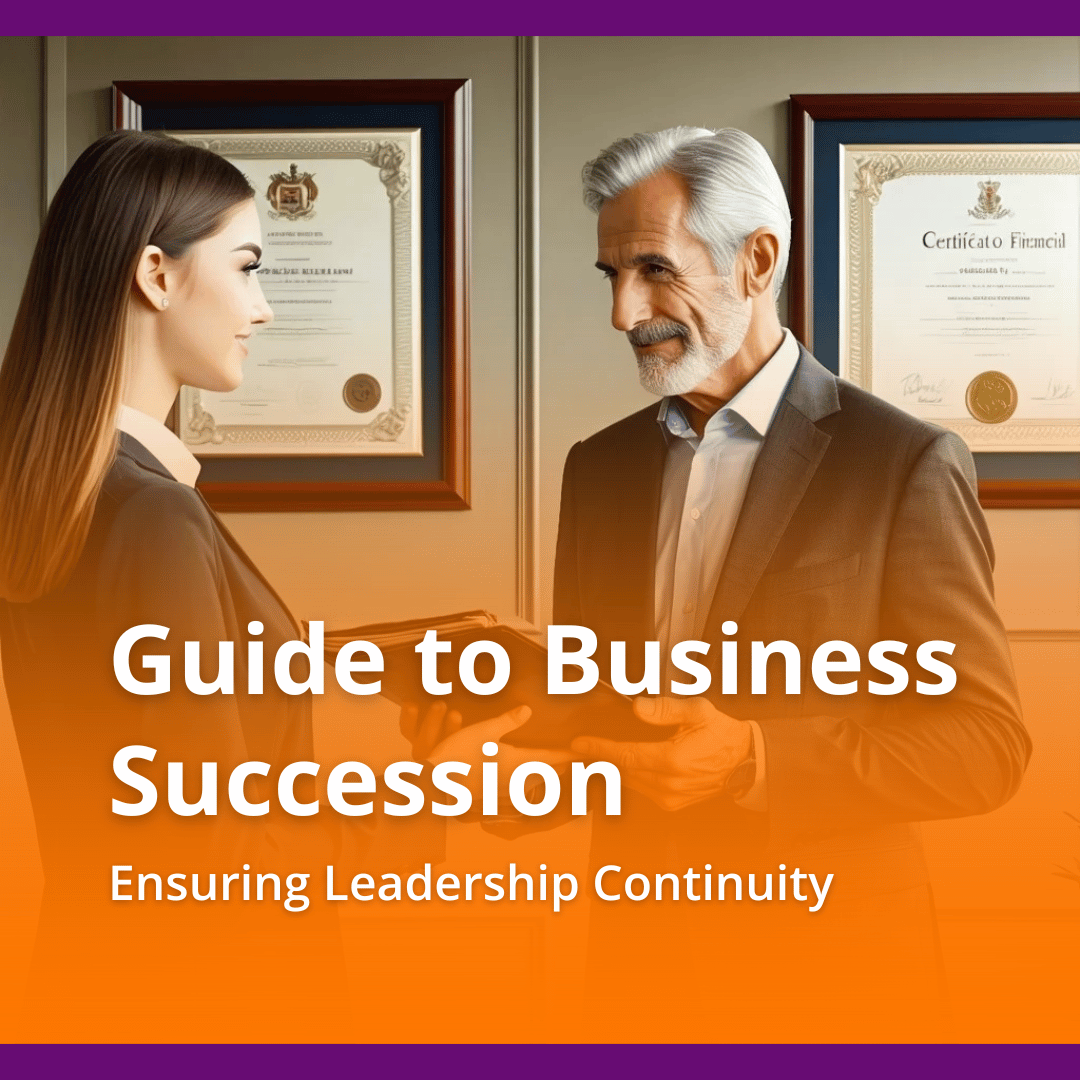Thinking of Selling Your Business? Document Your Operations First
Running a business means knowing every moving part. But to a buyer, that knowledge means nothing if it isn’t documented. And that’s a...
Comprehensive, data-driven valuations and comparative equity analyses to accurately price your practice, establish market benchmarks, and support informed decision-making.
Comprehensive M&A guidance encompassing deal structuring, negotiation strategies, market listings, and transaction closings.
Comprehensive systems, targeted coaching, and in-depth assessments designed to optimize operational efficiency and enhance advisory team effectiveness.
Strengthen continuity through the implementation of formal continuity agreements, the establishment of legal entities, execution of enforceable legal contracts, and securing appropriate capital resources.
10 min read
 Anthony Whitbeck, CFP®, CLU®
June 30, 2025
Anthony Whitbeck, CFP®, CLU®
June 30, 2025

What happens to your firm if you're not there tomorrow?
According to Harvard Business Review, a staggering 54% of board members report that their organizations do not have an effective process for CEO succession. This statistic points to a widespread vulnerability, one that is especially acute in advisory firms, where leadership continuity is essential to preserving client trust and firm value.
Many financial advisors devote years to helping clients plan for the future, but postpone succession planning for their own business. The assumption is that there will always be time later, but leadership transitions often arrive without warning. When no structured plan exists, clients notice the uncertainty, staff morale shifts, and the business begins to lose its footing. Succession planning is a methodical, forward-looking discipline that stabilizes operations, reinforces confidence, and prepares the firm to endure change without disruption.
This guide outlines how professional succession planning services, offered by specialists like Advisor Legacy, support financial advisors from evaluating current leadership structures to developing successor candidates and aligning legal, tax, and valuation strategies with long-term business goals. Whether a transition is five years out or rapidly approaching, the proper planning framework ensures the business continues to perform, regardless of who is in charge.
Succession planning services are professional, third-party engagements that provide advisory firm owners with a structured, managed process for their leadership and ownership transition. It is not a single product but a suite of coordinated activities that address the strategic, financial, and human elements of an exit. These services transform a large, often-postponed project into a series of clear, manageable stages, each building upon the last.
The foundational service is the initial strategic work. A professional partner works with the business owner to clarify their personal, financial, and legacy goals. This involves answering critical questions: What does a successful exit look like? What is the ideal timeline? Is the primary goal to maximize the sale price or to preserve the firm's culture? This service aligns the entire succession plan with the owner’s most important objectives from the very beginning.
This service focuses on the "people" side of the transition. A provider uses objective assessment tools—like 360-degree feedback and performance metrics—to evaluate the readiness of potential internal successors. Following the assessment, the partner helps design and oversee a tailored individual development plan (IDP) to close any skill gaps. This ensures the next leader is groomed with a mix of mentorship, new responsibilities, and cross-training to be fully prepared to take the reins.
This component addresses the mechanics of the transition itself. A professional partner conducts a formal, defensible business valuation to establish the firm’s market value. They then use specialized software to model various financial scenarios, helping structure a deal that meets the owner's requirements while addressing tax implications. This service coordinates the legal framework, ensuring buy-sell agreements and other documents are drafted correctly to govern the transfer of ownership.
A key service is ensuring the firm’s institutional wisdom is not lost during the transition. A partner helps systematize this knowledge transfer, from documenting client service models to outlining the firm’s investment philosophy. This stage also formalizes risk mitigation strategies. This includes ensuring buy-sell agreements are properly funded by insurance, creating a clear, legally binding contingency plan for unexpected events that protects the firm, its employees, and its clients.
Throughout the engagement, one of the most valuable services is acting as the central project manager for the entire transition. A succession partner coordinates the moving parts, working with the firm’s attorneys, accountants, and other stakeholders to keep the process on track. After the initial plan is built, it must be treated as a living document. The service includes establishing a cadence for annually reviewing and updating the plan to reflect changes in the firm, its team, and the market.
The importance of having a succession plan in place cannot be overstated, especially within the financial advisory industry, where trust and relationships are paramount. The planning process goes far beyond merely naming a successor; it involves a detailed strategy for leadership development, knowledge transfer, and business continuity that touches every aspect of your firm’s operations. A robust succession plan is a clear indicator of a stable and forward-thinking organization.
For an advisory firm, the foundation of its success is the trust built with clients over many years. A sudden or poorly managed leadership transition can fracture that trust instantly. An effective succession plan is the primary tool for ensuring business continuity. It provides a clear, transparent roadmap that reassures clients their financial well-being remains the firm’s top priority, regardless of who is at the helm. This process ensures the firm’s core values, investment philosophies, and unique culture are preserved and passed on to the next generation of leaders. The goal is to make the transition of leadership roles so seamless that the client experience remains consistently excellent, thereby safeguarding the relationships that are the lifeblood of the business. Proper succession planning ensures the organization can continue its business operations without disruption during a time of change.
Financial advisory firms face a unique set of risks when it comes to leadership transitions. The sudden departure of a founder or key employee without a plan can be catastrophic. This is because so much of the firm’s value is tied to intangible assets, such as deep client insight, specialized expertise, and personal relationships. Without a formal succession plan, this institutional knowledge can be lost overnight, leaving the remaining team scrambling and clients feeling abandoned. A poor transition can quickly lead to a damaged reputation, client attrition, and a significant loss of firm value. A comprehensive succession plan acts as a critical risk mitigation tool, creating clear protocols for knowledge transfer and contingency plans for unexpected events, ensuring the firm remains resilient.
A succession plan is also a powerful talent management and retention strategy. When high-performing team members see a clear pathway for their own growth and development within your organization, their engagement and loyalty deepen. The succession planning process involves identifying potential successors early and investing in their readiness to step into future leadership roles. This commitment shows your employees that their professional growth is a priority. Creating customized development plans, offering mentorship, and providing opportunities to take on more responsibility not only prepares them for key positions but also fosters a culture where talent is nurtured from within. This focus on internal growth and development is a key differentiator in a competitive market for advisory talent.
Ultimately, succession planning can help increase the saleability and overall value of your firm. A business with a well-defined and documented succession plan is a more attractive acquisition target because it demonstrates stability, lower risk, and a clear vision for the future. Whether you are planning an internal sale to a key employee, an external sale to a third party, or a merger, a strong succession plan gives you greater control over the outcome. It allows you to align the transition with your personal financial goals and timeline, ensuring you leave on your terms. You can be more selective in finding the right buyer who shares your firm’s values and is committed to its long-term success, ensuring the legacy you built continues to flourish.
Effective succession planning in the modern advisory firm is supported by a range of sophisticated tools and systems. Gone are the days of relying solely on spreadsheets and intuition. Today, technology and structured frameworks provide the data and clarity needed to make objective decisions, track progress, and ensure a seamless transition. Integrating these systems into your planning process transforms it from a theoretical exercise into a dynamic, manageable, and data-driven strategy that aligns with your business needs.
Dedicated succession planning software provides a centralized command center for managing the entire talent pipeline. These platforms are designed to help you identify critical roles, track high-potential employees, and monitor their progress through customized development plans. By integrating with broader Human Resources Information Systems (HRIS), this software can provide a holistic view of your workforce planning efforts. This allows firm owners to visualize talent strengths, identify gaps across the organization, and run scenarios for future leadership structures, making the process of identifying potential successors more systematic and strategic.
A cornerstone of identifying and developing talent is the use of objective assessment tools. To move beyond gut feelings, firms use systems that provide concrete data on employee performance and potential. Tools such as 360-degree feedback surveys, skills gap analyses, and behavioral assessments (like DiSC or Myers-Briggs) offer deep insights into an individual's strengths and areas for development. Frameworks like the 9-box grid, which plots individuals based on performance and potential, are powerful succession planning tools for visualizing the leadership bench and making unbiased, data-backed decisions about who is ready to step up.
A critical part of succession planning ensures that invaluable institutional knowledge does not walk out the door with the departing owner. Your Customer Relationship Management (CRM) system is a primary tool for this. When used diligently, a CRM is more than a contact list; it is a living record of client communication, preferences, and history that is essential for continuity. Beyond the CRM, dedicated knowledge management systems like internal wikis or shared document platforms (such as SharePoint or Notion) are used to formally document critical business operations, investment philosophies, and compliance procedures, creating a comprehensive playbook for the next generation of leaders.
The transition of ownership involves complex financial considerations that require precise calculations. Professional partners and valuation experts use specialized financial modeling software to determine a credible and defensible value for your business. This software is also used to model various transition scenarios and deal structures, whether it involves an earn-out, seller financing, or a third-party loan. This allows the business owner to see the long-term financial impact of different choices, understand tax liabilities, and structure an implementation plan that aligns perfectly with their personal and business financial goals.
Despite understanding its importance, a large number of advisory firms find themselves stuck when it comes to succession planning. They know they need a plan, but years go by with little to no progress. This inaction is rarely due to a lack of desire. Instead, firms struggle because they encounter a series of common, understandable, and very human challenges that make it difficult to move from intention to execution. Recognizing these specific struggles is the first step toward overcoming them.
For a busy firm principal, the sheer scale of a comprehensive succession plan can feel daunting. The process involves distinct and demanding workstreams: conducting a business valuation, creating development plans, navigating tax implications, and drafting complex legal agreements. When viewed as a single, monolithic project, it can seem like an insurmountable task on top of the daily responsibilities of serving clients and managing the business. This feeling of being overwhelmed is a primary reason many owners neglect to plan, pushing it off for a "less busy" time that never arrives.
Succession planning is as much about people as it is about processes. It forces profoundly difficult and emotional conversations. Talking with a business partner about retirement, discussing mortality and disability, or evaluating the true readiness of a loyal, long-time employee to take over are all conversations charged with personal and professional sensitivity. The potential for awkwardness, hurt feelings, or conflict causes many business owners to avoid these discussions entirely, leaving the most critical part of the planning process unaddressed.
The skills required to build a successful advisory practice are very different from the skills required to transition one. Executing a proper succession requires deep, specialized expertise in business valuation, M&A legal structures, tax law, and organizational development. Most advisory firms, regardless of their success, simply do not have this expertise on staff. When principals try to manage this long-term process themselves, they are forced to learn on the job in areas where mistakes can have significant financial and legal consequences, which often leads to errors or stalled progress.
A common mistake is viewing succession as a short-term transaction rather than a long-term strategic process. Many firm owners believe that a year or two is sufficient time to execute a plan. In reality, a successful succession—especially one involving an internal candidate who requires development—should be planned over a five-to-ten-year horizon. When firms fail to start the process early enough, they are left with fewer options, reduced negotiating leverage, and a rushed transition that puts client trust and firm value at risk.
Engaging a specialized succession planning partner provides advisory firms with structure, objectivity, and expertise that are difficult to replicate internally. While a business owner understands their firm intimately, an external expert brings a specialized perspective focused exclusively on securing successful transitions. They provide the necessary frameworks and guidance to transform succession planning from an ambiguous future task into a clear, actionable strategy. This partnership is designed to navigate complexities, mitigate risks, and ultimately achieve stronger outcomes for the owner, the employees, and the clients.
One of the most significant challenges in any succession planning process is managing the emotional dynamics and inherent biases that exist within a closely held firm. Current owners may have blind spots regarding the true readiness of an internal successor or the firm's operational weaknesses. A professional partner offers an objective, third-party perspective, facilitating the difficult but necessary conversations between current leaders and a potential successor. This unbiased guidance ensures that decisions are based on data and proven best practices rather than sentiment, reducing friction and aligning all parties toward a common set of planning goals that serve the long-term health of the business.
A professional partner eliminates guesswork by providing a suite of proven succession planning tools and frameworks. Instead of starting from scratch, you gain access to structured succession planning templates, detailed individual development plan (IDP) formats, and sophisticated practice value forecasting models. These resources are specifically designed for the advisory industry and are customized to your firm's unique situation. This streamlined process ensures no critical step is missed, from identifying critical roles to establishing a concrete implementation plan. Using these established frameworks saves valuable time and provides confidence that your plan is comprehensive and built upon successful precedent.
Succession planning does not exist in a vacuum. It is deeply interconnected with business valuation, legal structuring, M&A strategy, and leadership coaching. A key advantage of working with a firm like Advisor Legacy is the cross-functional integration of these services. This holistic approach ensures your succession plan is perfectly aligned with your financial valuation and legal agreements. Having a single team manage these interconnected parts prevents critical details from getting lost in translation between separate legal, financial, and coaching advisors. This synergy results in fewer handoffs, more efficient execution, and a more robust and resilient final plan.
Building a strong legacy involves preparing a diverse and capable next generation of leaders. A modern succession planning partner helps incorporate inclusive principles into the talent identification and development process. This means looking beyond the obvious candidates and creating pathways for growth for individuals from different backgrounds and roles within your organization. This approach not only strengthens your firm by fostering a wider range of perspectives in future leadership but also enhances your firm’s culture and appeal in a competitive talent market. By intentionally identifying and developing a diverse leadership pipeline, you create a more resilient organization and a more impactful legacy.
Succession planning is not a matter of if, but when. For firms built on trust, consistency, and high-stakes decision-making, leaving the future unstructured invites unnecessary risk. The absence of a formal succession plan leaves clients exposed, staff uncertain, and firm value vulnerable.
A qualified succession planning partner brings clarity and discipline to what is often a delayed and emotionally charged process. Advisor Legacy offers financial advisors the tools, experience, and cross-disciplinary expertise to turn succession from a looming uncertainty into a structured plan of action. This includes documented development frameworks, customized transition timelines, valuation models, and integrated legal and M&A support, all designed specifically for advisory firms.
Too often, advisors delay this work until circumstances force a rushed decision. Planning early allows you to retain control, preserve your legacy, and create long-term stability for those who rely on your business. A structured succession plan is an operational necessity that protects what you’ve built and ensures continuity well beyond your tenure.
Speak with a succession planning expert at Advisor Legacy and take the first step toward building a firm that endures.
Anthony "Tony" Whitbeck, CFP®, CLU®, is CEO and Owner of Advisor Legacy. He began his career as a financial advisor in 1989 and later shifted to coaching, where he’s guided more than two hundred advisory practices through growth, valuation, and succession. Tony leads Advisor Legacy’s certified third-party valuation engagements and coordinates lending and legal partners to streamline transactions. His articles focus on building transferable enterprise value, mapping internal vs. external exits, and avoiding common succession pitfalls. Drawing on decades of in-the-trenches experience, Tony provides practical, compliance-friendly guidance advisors can use right away.
Receive timely articles, tip sheets, events, and more right in your inbox.

Running a business means knowing every moving part. But to a buyer, that knowledge means nothing if it isn’t documented. And that’s a...

Growing by acquisition is one of the fastest ways to scale — but it’s also one of the easiest ways to stumble. Behind every successful deal is a...

The M&A landscape in financial services isn’t slowing down. It’s evolving. Fast. As of mid-2025, deal values in the sector have surged by...